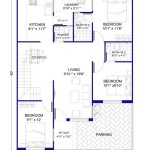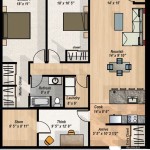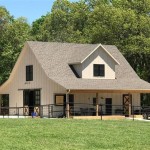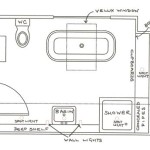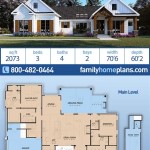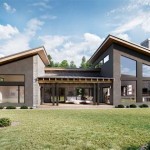Ranch Style House Plans With Basement: Expanding Space and Functionality
Ranch style houses, characterized by their single-story layout, low-pitched roofs, and sprawling floor plans, remain a popular housing choice across various regions. The addition of a basement to a ranch style house plan significantly enhances its functionality and living space. This combination offers a unique blend of accessibility, affordability, and adaptability, making it an attractive option for a wide range of homeowners.
This article explores the advantages and considerations involved in choosing ranch style house plans with basements, examining various aspects from design considerations to potential cost implications.
Advantages of Ranch Style House Plans with Basements
Integrating a basement into a ranch style house plan provides several key advantages that address both practical and lifestyle needs.
Firstly, a basement substantially increases the total square footage of the home without altering its exterior footprint. This is particularly beneficial in areas where land is expensive or restricted. The basement space can be utilized for a variety of purposes, including additional bedrooms, recreational areas, home offices, storage, or even a separate rental unit, significantly enhancing the property's value and versatility.
Secondly, basements provide excellent protection from severe weather. In regions prone to tornadoes, hurricanes, or extreme cold, a basement serves as a safe refuge. It provides a secure location during storms and offers a buffer against temperature fluctuations, helping to maintain a more consistent climate within the main living areas above.
Thirdly, the basement offers significant flexibility for future modifications and additions. As family needs change over time, the basement can be easily adapted to accommodate new requirements. It can be converted into a home theater, a gym, a workshop, or any other specialized space without requiring extensive and disruptive renovations to the main living areas of the house.
Design Considerations for Ranch Style House Plans with Basements
Designing a ranch style house plan with a basement requires careful consideration of several factors to ensure structural integrity, functionality, and aesthetic appeal.
Soil conditions and drainage are paramount. Before construction begins, a thorough soil analysis is essential to determine the type of soil and its load-bearing capacity. This information is crucial for designing a foundation that can withstand the weight of the house and resist the effects of soil movement. Adequate drainage systems, including French drains and proper grading around the foundation, are also necessary to prevent water from accumulating and potentially damaging the basement walls.
The foundation design is a critical aspect of the overall plan. Common foundation types for basements include poured concrete walls, concrete block walls, and precast concrete panels. Poured concrete walls are generally considered the strongest and most water-resistant option, while concrete block walls are more economical but may require additional waterproofing. The choice of foundation type depends on factors such as soil conditions, budget, and local building codes.
Access to the basement is another important design consideration. Interior access is typically provided via a staircase leading from the main living area. Exterior access, such as a walk-out basement or separate entrance, can enhance the basement's functionality and privacy, particularly if it is intended for use as a rental unit or home office. The placement and design of windows and doors in the basement are also crucial for providing natural light and ventilation, making the space more habitable and comfortable.
Integrating the basement design with the overall aesthetic of the ranch style house is also important. The exterior of the house should blend seamlessly with the basement's exposed elements, such as walk-out entrances or window wells. Landscaping can be used to soften the transition between the house and the surrounding terrain, creating a cohesive and visually appealing design.
Cost Implications of Adding a Basement to a Ranch Style House
Adding a basement to a ranch style house plan significantly affects the overall construction cost. Understanding these cost implications is crucial for budgeting and making informed decisions throughout the design and construction process.
Excavation is a primary cost factor. The process of excavating the ground to create the basement space requires specialized equipment and labor. The cost of excavation depends on the size of the basement, the depth of the excavation, and the type of soil. Rocky or unstable soil conditions can significantly increase excavation costs due to the need for additional reinforcement and stabilization measures.
Foundation construction is another major expense. The cost of building the foundation depends on the type of material used, the size of the foundation, and the complexity of the design. Poured concrete walls are generally more expensive than concrete block walls, but they offer superior strength and water resistance. Additional costs may be incurred for waterproofing, insulation, and drainage systems.
Finishing the basement adds further to the overall cost. The extent to which the basement is finished depends on its intended use. A basic unfinished basement may only require minimal improvements, such as painting the walls and adding lighting. However, a fully finished basement with bedrooms, bathrooms, and recreational areas can significantly increase the cost, potentially doubling or tripling the initial expenditure on the unfinished space. The cost of finishing the basement includes expenses for framing, insulation, drywall, flooring, plumbing, electrical work, and fixtures.
Permitting and regulatory compliance also contribute to the overall cost. Building permits are required for constructing a basement, and the cost of these permits varies depending on the location and the scope of the project. It is essential to comply with all local building codes and regulations to ensure the safety and legality of the construction. Failure to comply with these regulations can result in fines, delays, and costly rework.
Structural Considerations and Engineering Requirements
Designing and constructing a ranch style house with a basement necessitates meticulous attention to structural integrity and adherence to stringent engineering requirements.
Proper foundation design is paramount to ensure the long-term stability and safety of the structure. The foundation must be designed to withstand the vertical loads imposed by the house above, as well as the lateral pressure exerted by the surrounding soil. Soil testing is crucial to determine the soil's bearing capacity and potential for expansion or contraction. A structural engineer should be consulted to design a foundation that meets the specific requirements of the site and complies with local building codes.
Waterproofing and drainage are critical components of basement construction. Proper waterproofing prevents moisture from penetrating the foundation walls, which can lead to mold growth, structural damage, and health problems. Various waterproofing methods are available, including applying waterproof coatings to the exterior of the foundation walls, installing drainage membranes, and using water-resistant concrete mixtures. Effective drainage systems, such as French drains and sump pumps, are essential for removing water that accumulates around the foundation.
Load-bearing walls and support columns are necessary to distribute the weight of the house evenly throughout the basement. The placement and design of these structural elements must be carefully considered to ensure the stability of the house and prevent sagging or settling. A structural engineer should be consulted to determine the appropriate size and spacing of load-bearing walls and support columns.
Egress windows and emergency exits are essential safety features in basements. Egress windows provide a means of escape in the event of a fire or other emergency. They must meet specific size and location requirements to comply with building codes. Emergency exits, such as walk-out doors or stairwells leading to the exterior, provide an alternative escape route in case the primary egress window is blocked.
Utilizing Basement Space Effectively
Optimizing the use of basement space requires careful planning and design to create functional and comfortable living areas.
Creating additional living space is a popular use of basements. Bedrooms, bathrooms, family rooms, and home offices can be incorporated into the basement design to expand the living area of the house. Careful consideration should be given to lighting, ventilation, and soundproofing to create comfortable and inviting spaces. Natural light can be maximized by installing larger windows or window wells.
Storage solutions are another practical application of basement space. Basements provide ample room for storing seasonal items, household goods, and other belongings. Shelving, cabinets, and storage containers can be used to organize and maximize the storage capacity of the basement. A well-organized storage area can help to declutter the main living areas of the house.
Recreational areas can be created in the basement to provide entertainment and relaxation. Home theaters, game rooms, and exercise rooms are popular choices for basement recreational areas. Soundproofing is essential for minimizing noise transmission to the main living areas of the house. Proper ventilation and climate control are also important for creating a comfortable and enjoyable recreational space.
Home offices and workshops are increasingly common uses of basement space. A dedicated home office can provide a quiet and productive workspace, separate from the distractions of the main living areas. Workshops can be used for hobbies, crafts, and DIY projects. Proper lighting, ventilation, and electrical outlets are essential for creating a functional and safe workspace.
Considerations for accessibility are crucial, particularly for homeowners planning to age in place. Installing ramps, wider doorways, and accessible bathrooms can make the basement more accessible for individuals with mobility limitations. Accessible design features can enhance the usability and value of the basement for all residents.
Integrating Utilities and Services in the Basement
Properly integrating utilities and services into the basement is crucial for ensuring its functionality and habitability.
Plumbing is an essential consideration for basements with bathrooms, kitchens, or laundry rooms. Installing plumbing in a basement may require extending existing plumbing lines or installing new lines. A backflow preventer should be installed to prevent sewage from backing up into the basement in the event of a sewer system failure. Proper ventilation is also necessary to prevent the accumulation of moisture and odors.
Electrical wiring is necessary for powering lights, appliances, and other electrical devices in the basement. It is essential to comply with all electrical codes and regulations to ensure the safety of the electrical system. Ground fault circuit interrupters (GFCIs) should be installed in areas where water is present to prevent electrical shocks. Adequate lighting is also important for creating a safe and functional basement environment.
Heating, ventilation, and air conditioning (HVAC) systems are necessary for maintaining a comfortable temperature and air quality in the basement. Extending existing HVAC systems or installing new systems may be required. Proper insulation is essential for minimizing heat loss and energy consumption. Dehumidifiers can be used to control humidity levels and prevent mold growth.
Internet and cable access are important for connecting the basement to the outside world. Running internet and cable lines to the basement may require drilling through walls or floors. Wireless access points can be used to extend Wi-Fi coverage throughout the basement.
Proper ventilation is crucial for preventing moisture buildup and maintaining air quality in the basement. Ventilation systems can include windows, exhaust fans, and air exchangers. Dehumidifiers can be used to remove excess moisture from the air. Regular maintenance of ventilation systems is important for ensuring their effectiveness.

Ranch Style House Plans With Basement All About Floor And More

Ranch Homeplans Walk Out Basement Unique House Plans Floor

3 7 Bedroom Ranch House Plan 2 4 Baths With Finished Basement Option 187 1149

Versatile Spacious House Plans With Basements Houseplans Blog Com

Country Ranch Plan With Optional Unfinished Basement 135142gra Architectural Designs House Plans

Open Plan Ranch With Finished Walkout Basement Hwbdo77020 House From Builderhousepla Floor Plans

The House Designers Thd 4968 Builder Ready Blueprints To Build A Craftsman Ranch Plan With Walkout Basement Foundation 5 Printed Sets Com

Sprawling Craftsman Style Ranch House Plan On Walkout Basement 890133ah Architectural Designs Plans

Ranch Home Plans Building Blueprints Layouts

R 401 Ranch Basement Floor Plan For House By Creativehouseplans Com


